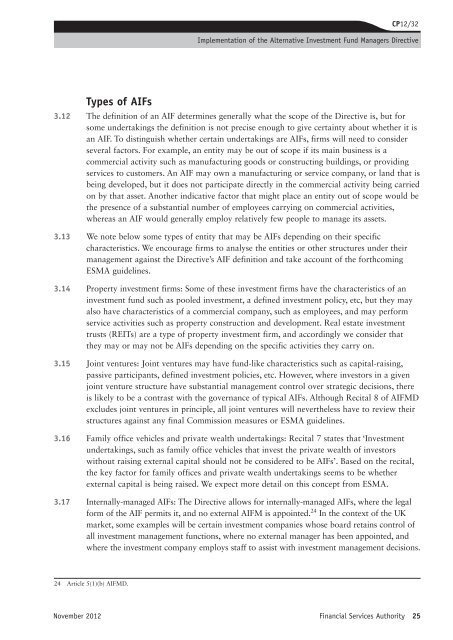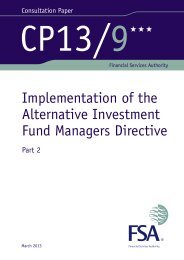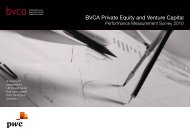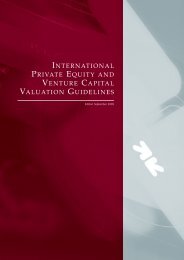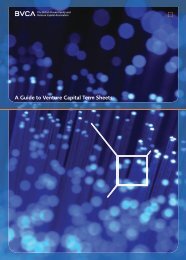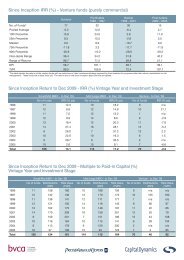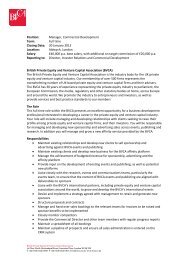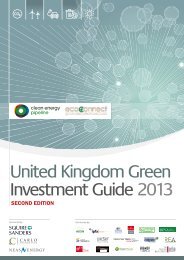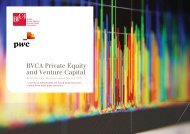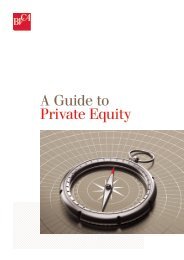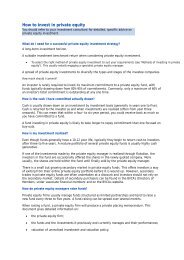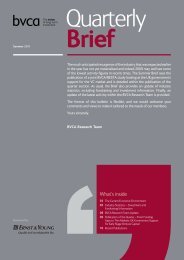CP12/32: Implementation of the Alternative ... - BVCA admin
CP12/32: Implementation of the Alternative ... - BVCA admin
CP12/32: Implementation of the Alternative ... - BVCA admin
You also want an ePaper? Increase the reach of your titles
YUMPU automatically turns print PDFs into web optimized ePapers that Google loves.
November 2012<br />
Types <strong>of</strong> AIFs<br />
<strong>CP12</strong>/<strong>32</strong><br />
<strong>Implementation</strong> <strong>of</strong> <strong>the</strong> <strong>Alternative</strong> Investment Fund Managers Directive<br />
3.12 The definition <strong>of</strong> an AIF determines generally what <strong>the</strong> scope <strong>of</strong> <strong>the</strong> Directive is, but for<br />
some undertakings <strong>the</strong> definition is not precise enough to give certainty about whe<strong>the</strong>r it is<br />
an AIF. To distinguish whe<strong>the</strong>r certain undertakings are AIFs, firms will need to consider<br />
several factors. For example, an entity may be out <strong>of</strong> scope if its main business is a<br />
commercial activity such as manufacturing goods or constructing buildings, or providing<br />
services to customers. An AIF may own a manufacturing or service company, or land that is<br />
being developed, but it does not participate directly in <strong>the</strong> commercial activity being carried<br />
on by that asset. Ano<strong>the</strong>r indicative factor that might place an entity out <strong>of</strong> scope would be<br />
<strong>the</strong> presence <strong>of</strong> a substantial number <strong>of</strong> employees carrying on commercial activities,<br />
whereas an AIF would generally employ relatively few people to manage its assets.<br />
3.13 We note below some types <strong>of</strong> entity that may be AIFs depending on <strong>the</strong>ir specific<br />
characteristics. We encourage firms to analyse <strong>the</strong> entities or o<strong>the</strong>r structures under <strong>the</strong>ir<br />
management against <strong>the</strong> Directive’s AIF definition and take account <strong>of</strong> <strong>the</strong> forthcoming<br />
ESMA guidelines.<br />
3.14 Property investment firms: Some <strong>of</strong> <strong>the</strong>se investment firms have <strong>the</strong> characteristics <strong>of</strong> an<br />
investment fund such as pooled investment, a defined investment policy, etc, but <strong>the</strong>y may<br />
also have characteristics <strong>of</strong> a commercial company, such as employees, and may perform<br />
service activities such as property construction and development. Real estate investment<br />
trusts (REITs) are a type <strong>of</strong> property investment firm, and accordingly we consider that<br />
<strong>the</strong>y may or may not be AIFs depending on <strong>the</strong> specific activities <strong>the</strong>y carry on.<br />
3.15 Joint ventures: Joint ventures may have fund-like characteristics such as capital-raising,<br />
passive participants, defined investment policies, etc. However, where investors in a given<br />
joint venture structure have substantial management control over strategic decisions, <strong>the</strong>re<br />
is likely to be a contrast with <strong>the</strong> governance <strong>of</strong> typical AIFs. Although Recital 8 <strong>of</strong> AIFMD<br />
excludes joint ventures in principle, all joint ventures will never<strong>the</strong>less have to review <strong>the</strong>ir<br />
structures against any final Commission measures or ESMA guidelines.<br />
3.16 Family <strong>of</strong>fice vehicles and private wealth undertakings: Recital 7 states that ‘Investment<br />
undertakings, such as family <strong>of</strong>fice vehicles that invest <strong>the</strong> private wealth <strong>of</strong> investors<br />
without raising external capital should not be considered to be AIFs’. Based on <strong>the</strong> recital,<br />
<strong>the</strong> key factor for family <strong>of</strong>fices and private wealth undertakings seems to be whe<strong>the</strong>r<br />
external capital is being raised. We expect more detail on this concept from ESMA.<br />
3.17 Internally-managed AIFs: The Directive allows for internally-managed AIFs, where <strong>the</strong> legal<br />
form <strong>of</strong> <strong>the</strong> AIF permits it, and no external AIFM is appointed. 24 In <strong>the</strong> context <strong>of</strong> <strong>the</strong> UK<br />
market, some examples will be certain investment companies whose board retains control <strong>of</strong><br />
all investment management functions, where no external manager has been appointed, and<br />
where <strong>the</strong> investment company employs staff to assist with investment management decisions.<br />
24 Article 5(1)(b) AIFMD.<br />
Financial Services Authority 25


